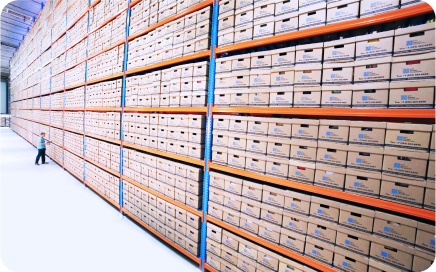How to Measure the Success of Your Inventory Management: 5 Formulas That Make a Difference
By Rackbeat August 9, 2024

You Can’t Raise a Well-Functioning Warehouse Without the Right Effort
Much like some children are raised better than others, your inventory and order process can be managed either well or poorly.
And just like the impact of upbringing on an adult’s personality, the way you handle your inventory management and order management makes a huge difference for your business in the long run.
It determines whether you cultivate satisfied customers and profit from your goods or scare people away due to delays and lose money on your inventory operations.
But how do you really know if development is going in the right direction? Or more directly: How do you gauge how good your inventory management is?
You do this with 5 specific focus areas consisting of your:
- Inventory turnover
- Inventory accuracy
- Order fulfillment time
- Storage capacity utilization
- Return rate
In this post, we provide you with tailored formulas so you can measure how your business performs in these five areas. We will elaborate on the formulas so you don’t have to go back to school and solve quadratic equations to improve your inventory management.
You will also get an explanation of why the 5 focus areas are important for your inventory-driven business and the benchmarks for success.
But, but. It’s not enough just to point out a child’s less favorable traits. Therefore, we also give you some advice on how you can support your warehouse’s development in a positive direction.
For when you know where to make improvements to achieve success, you are more likely to look back on your efforts with pride and see your business unfold its full potential.
1. Inventory Turnover
Your inventory turnover is one of the most important measurements to assess the efficiency of your inventory management and how your sales are going. Your inventory turnover shows how quickly your goods are sold and replenished within a given period.
A high inventory turnover is a positive sign that your company can effectively balance supply and demand, and you significantly reduce the risk of obsolete goods with a high turnover rate.
However, it is important to note that an extremely high turnover rate can also indicate that the inventory is too small to meet demand, which can lead to stockouts and lost sales. Therefore, it is crucial to find the right balance for your business.
What Is a High Inventory Turnover?
- Retail: For groceries and other fast-moving goods (e.g., food, beverages), an inventory turnover of 10-15 is considered high.
- Wholesale: For wholesalers selling large quantities of goods to other businesses, an inventory turnover of 5-7 is considered high.
- Electronics: For consumer electronics, an inventory turnover of 4-8 is considered high, as products often have high value and do not necessarily sell as quickly as groceries.
- Apparel: For clothing and fashion, an inventory turnover of 4-6 is considered high, depending on seasonal demand and fashion cycles.
How to Calculate Your Inventory Turnover
![]()
“Cost of Goods Sold” primarily covers the purchase prices of the sold goods. Additionally, if you work with manufacturing, it covers the direct costs associated with producing the goods sold by the company in a given period. This includes costs for raw materials, labor, and other production costs.
“Average Inventory” is the average value of the inventory over a specific period. It is calculated by taking the average of the beginning inventory and ending inventory for the analyzed period.
The beginning inventory is the value of the inventory at the start of the period, and the ending inventory is the value of the inventory at the end of the period. By averaging these two figures, you get a more accurate picture of the inventory throughout the period.
How to Calculate Your Average Inventory
![]()
How to Achieve a High Inventory Turnover?
- Demand planning: Use data analysis and forecasting to accurately predict demand and adjust inventory accordingly.
- Just-In-Time (JIT): Implement JIT inventory management to receive goods just when needed, reducing inventory costs and improving turnover.
- Product mix: Ensure you have the right products in stock based on demand and sales history.
- Customer engagement: Understand your customers’ needs and preferences to better tailor your inventory management.
2. Inventory Accuracy
Another crucial indicator of your inventory management is your “inventory accuracy.” Inventory accuracy measures how precise your inventory records are compared to the actual physical inventory.
High accuracy means fewer inventory discrepancies, reducing the risk of understocking, which can result in order delivery delays. At the same time, high inventory accuracy helps lower the risk of overstocking, meaning you have too much money tied up in your goods.
Furthermore, high inventory accuracy allows you to work with reliable data, strengthening your purchasing management and decision-making overall.
What Is High Inventory Accuracy?
- Generally, an inventory accuracy of 97% or higher is considered “high.” This means that 97% of the time, the inventory records are correct and match the physical inventory. In some industries, especially those with high values or strict regulations (e.g., pharmaceutical products), there may be an expectation of even higher accuracy, closer to 99% or even 99.9%.
- A “low” inventory accuracy is generally considered to be under 95%.
Causes of Low Inventory Accuracy
- Manual errors: Incorrect entries or incomplete records.
- Lack of updates: Inventory data is not updated in real-time, resulting in outdated records.
- Fraud: Theft or fraud by employees can lead to discrepancies between recorded and actual inventory.
How to Calculate Your Inventory Accuracy
![]()
How to Achieve High Inventory Accuracy?
- Regular inventory counts: Conduct regular inventory counts to ensure records match the actual inventory.
- Use software: Invest in a Warehouse Management System (WMS) that can track inventory movements in real-time and reduce manual errors
- Quality control: Implement quality control points in inventory management processes to catch and correct errors early.
3. Order Fulfillment Time
Your order fulfillment time measures how long it takes to process and ship an order from the moment you receive it from your customer. Shorter order fulfillment times indicate that your order management is efficient, as you can process orders quickly, leading to high customer satisfaction.
What Is a High Order Fulfillment Time?
E-commerce: Many e-commerce companies aim for an order fulfillment time of 24-48 hours to meet customers’ expectations for fast delivery.
Wholesale: For wholesalers, an order fulfillment time of 2-4 days is acceptable, depending on the complexity of the orders and delivery agreements.
Retail: For retailers with both online and physical stores, an order fulfillment time of 1-2 days is often standard, especially for click-and-collect orders.
Manufacturing: For manufacturing companies where products may need to be produced before delivery, the order fulfillment time can be longer, typically 1-2 weeks depending on the production cycle.
How to Calculate Your Order Fulfillment Time
![]()
How to Achieve a High Order Fulfillment Time?
- Inventory system: Using a warehouse management system will help systematize and speed up your picking, packing, and shipping processes and provide you with real-time updates on order statuses.
- Integration of systems: Integrate the warehouse management system with your webshop and POS to ensure a smooth information flow and faster processing of customer orders.
- Efficient warehouse layout: Organize the warehouse so that the most in-demand items are easily accessible, reducing picking time. We have also created a guide to optimize your warehouse layout.
4. Storage Capacity Utilization
Storage capacity utilization measures how well you utilize your available storage space. Efficient use of your storage capacity is crucial as it can help reduce your storage costs and increase your order fulfillment time, as picking and packing become easier and more manageable with an optimized storage space.
When you have control over your storage space, you also avoid overloading your warehouse, which can cause dangerous working conditions in the worst cases. Finally, you will also be much better positioned to plan a possible scaling of your storage if this becomes necessary.
What Is High Capacity Utilization?
- High capacity utilization is as close to 100% as possible. However, you should be aware that a percentage close to 100 can indicate that the warehouse is getting full, which can create problems with overloading and reduced efficiency.
- Capacity utilization is low if it is around 50%, and this can mean that there is a lot of wasted space, which can be very costly, as you often pay for unused space – especially if you rent a warehouse.
How to Calculate Your Storage Capacity Utilization
![]()
Note: Both used and available storage space are measured in square meters.
How to Achieve High Storage Capacity Utilization?
- Use vertical space: Implement shelves and racks to effectively use vertical space.
- Reorganize the warehouse: Ensure items are strategically placed to maximize space utilization and minimize wasted space
- Regular audits: Conduct regular warehouse audits to identify areas where space can be better utilized
- Lean principles: Implement lean inventory principles to reduce waste and improve efficiency.
5. Return Rate
Your return rate measures the proportion of goods that your customers return after purchase. The return rate is good to keep an eye on as it can provide insights into potential problems with inventory management, such as incorrect items, damaged goods, or delivery delays.
A high return rate is usually not desirable as it can indicate problems with product quality, customer satisfaction, or errors in order processing.
What Is a High Return Rate?
What is considered a high return rate can vary depending on your industry and product type. But here are some general guidelines:
Apparel and fashion: Return rates of 20-30% are not uncommon as customers often order multiple sizes or styles to try at home.
Electronics: Return rates of 5-10% are common due to technical issues or lack of conformity with customer expectations.
Groceries: Return rates are typically very low, often under 1%, as groceries are rarely returned unless there are errors or quality issues.
General retail goods: A return rate of 5-10% is fairly typical.
How to Calculate Your Return Rate
![]()
How to Avoid a High Return Rate?
- Clear and precise product information: Provide detailed and accurate product descriptions and images to ensure customers know what they are buying. If you sell clothing, a size guide is invaluable.
- Optimize order processing: Implement systems and processes to minimize errors in order processing.
- Customer feedback: Collect and analyze customer feedback on the reasons for returns and implement changes based on this feedback.
- Return policy: Review and adjust the return policy to find a balance between customer satisfaction and business sustainability.
- Data analysis: Use data analysis to identify patterns in returns and target specific products or categories for improvement.
After reviewing these five focus areas, we hope it has become clear how important it is to measure and optimize key aspects of your inventory management.
By focusing on your inventory turnover, inventory accuracy, order fulfillment time, storage capacity utilization, and return rate, you will get a very clear picture of where your business stands and where there is room for improvement.
Want More Tips for Your Inventory Management?
If you would like to further strengthen your inventory management, we have created a checklist for effective inventory management that you can start checking off.
You can also take a closer look at how Rackbeat’s inventory solution will immediately enhance your inventory and order management.




